LA QUINTA, CALIFORNIA, US — War, weather, economic tension and tight global supplies continue to drive volatility across multiple commodities, experts said at the International Sweetener Colloquium in La Quinta, California, US, on March 1.
Global stocks of grain and oilseeds still were tight amid continually strong demand, and the outlook for those markets remained uncertain.
“There are many swing factors in play from what’s going to happen to the economy to unstable geopolitical situations,” said Stephen Nicholson, executive vice president, global sector strategist for grains and oilseeds at RaboResearch Food and Agribusiness.
One major market factor Nicholson touched on was weather, saying drought continues to impact major grain producing areas in several countries, including the United States, which has seen multiple declining years in its stocks to use ratios for wheat.
“We now have the worst conditions for winter wheat production in the United States than we’ve ever had before,” Nicholson said. “It will be a challenge to see what kind of crops we’ll have since everything needs to be perfect going forward, which will ultimately keep prices supported until we see what we have.”
A recent forecast for a bumper corn crop in the United States had minor influence on the market as analysts considered the current squeeze on profit margins from previous years’ issues with prolonged dryness. In the past 12 years, the Corn Belt has only experienced one drought-free year in 2015.
“Barring any weather issues, we’re going to see a bigger corn crop because they’re going to plant as much as they can, but I don’t think we’ll go back to $4 or even $5 a bushel corn,” Nicholson said.
This year’s crop will be dependent on timely rains since years of dryness throughout parts of the Corn Belt has depleted soil moisture levels, which affects yields. Nicholson projected 2023-24 corn prices to range from $5.50 to $6.75 a bushel.
Even the mammoth soybean crop in Brazil was struggling with weather effects. Heavy rains were delaying its harvest, potentially narrowing the country’s window to maximize yields, and delaying planting of the follow-on corn crop.
Ukrainian grain exports from select Black Sea ports had stabilized, but the humanitarian agreement allowing safe passage was under persistent threat from Russia's invasion. Efforts to fortify infrastructure supportive of alternate export channels were underway in Ukraine, but they also served as new vulnerable targets for future militaristic attacks.
“We also have to think about what’s happening in the Middle East,” Nicholson said. “That region has a leadership vacuum and there are players from Iran, Pakistan, Turkey and Israel all wanting to make a stand, and if something happens in this area, then oil prices are going to rocket up, which will impact all commodities.”
Nicholson also expects soybean and soybean oil prices to be well supported due to robust demand, increasing crush, strong crush margins and growing demand from the biofuels sector. Soybean oil prices have fallen from peak levels in 2022 where they neared 80¢ a pound but are now trying to find support around 58¢ a pound, which may be a purchasing opportunity for some users.
“From a buyer’s perspective, you have to find a good reason not to put coverage on because soybean oil will likely be well supported going forward,” Nicholson said.
Prices for soybean oil have come down partly due to constrained demand from renewable diesel plants, which haven’t come online as fast as the market anticipated. Also, demand for soybean meal has surged. Traders long on soybean meal have reached near record levels, but Nicholson indicated the ascent of soybean meal and the bullish spread between meal and oil was a bit precarious.
“When you talk to livestock producers, they’re frustrated at the high prices,” Nicholson said, adding that the historic spread between the two products could switch places soon, especially since the demand for renewable diesel feedstocks is expected to grow, which has spurred an explosion in renewable diesel refineries whose major feedstock is vegetable oil.
“But, should all the renewable diesel production capacity be realized, there will still not be enough vegetable oil domestically or globally to meet the demand,” Nicholson cautioned.
After a production surge in 2020-21, global dairy markets saw a sharp decline in global dairy products in 2021-22 and analysts are forecasting a slow recovery for current and future dairy markets worldwide.
“During the pandemic, dairy farmers across the world got the signal to produce more products,” said Mary Ledman, global strategist for dairy at Rabobank. But weather, diminished export opportunities and higher feed costs have pressured recent production. The United States, for instance, saw a reduction in the average compound growth rate of dairy production largely due to compressed profit margins from rising feed costs.
“We’ve had a correction in milk prices, but farmers are still having to buy expensive feed,” Ledman said. “If corn prices get back down to $4 a bushel, then we can turn the faucets back on in dairy.”
But $4 corn is anticipated.
Reduced product flows to China, the world’s largest importer of dairy goods, also have impacted production in exporting countries.
“China imported 850,000 tonnes of milk powder in 2021, but they came into the market at 200,000 tonnes less in 2022, which caused the market to feel underwhelmed from a demand standpoint,” Ledman said.
But US exports of some dairy products, like butterfat, actually increased last year, Ledman said.
“The United States is picking up the market’s share of exports,” she said, explaining US exports of butterfat were expected to increase nearly 9% since US prices are currently some of the lowest in the world.
US trade of some dairy products to China had increased, such as exports of dry whey and other protein-heavy dairy ingredients to meet China’s robust demand for animal feed and infant formula products. Global dairy stocks were modestly increasing with the United States leading the way, but Ledman cautioned that any type of market event could result in major price upswings.






